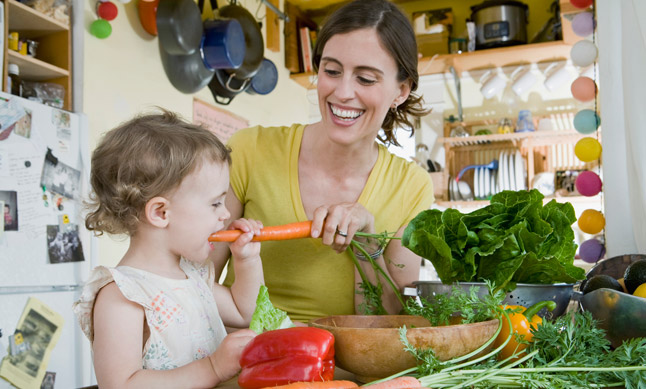Stage
How long is too long for your homemade purées?
Chances are that if you are taking time out to prepare a delicious mango-blueberry puree for your baby, that you are going to make more than one 3-ounce serving in the process. Sure, there are times when you will make just enough of something to cover a meal. For the most part, if you have decided to make your own baby food, then there are probably several mango-blueberry breakfasts in your child’s future. And since variety is the spice of life, remember the following when storing your home made baby food batches.
Storage containers:
Store purées, smoothies, mushes and mashes in clean, covered containers in the refrigerator or freezer. If you are going to keep the food for longer than a couple of days, it should be frozen. Choose a container for the freezer that can also be covered and that is appropriately sized for single serving portions. Flexible storage pods or ice cube trays are popular choices – just make sure they can be sealed. Once frozen solid, you can store the puree pops in a plastic freezer bag.
Use by dates:
Unlike store-bought food, there isn’t a use by date on the pea puree you made last Saturday. It is important to note that baby food spoils faster than other prepared foods because it has been pureed or ground. A general rule of thumb is to use any refrigerated purees within 1-2 days of making, and frozen purees should be used within 1 month. Fruit and vegetable purees will last longer in the refrigerator (2-3 days) than meats or eggs (1 day). Discard any food containers that are bulging as they may contain a gas produced by C botulinum, which causes botulism. If you’re not sure, it’s always better to discard the item in question. Once a frozen food has been defrosted, it cannot be refrozen. Throw away any uneaten food – saving leftovers is only for big kids, when purées have been replaced by spaghetti and meatballs.
Heating instructions:
Heat food to hot and then let it cool to a lukewarm temperature (not hot!) before feeding baby. This will help to destroy toxins. To heat, put frozen cubes or refrigerated puree in a clean glass custard cup – or similar dish – and set it in a pan of hot water to thaw. You can also heat food in a microwave – heat 4 ounces of food for 15 seconds at a time. Stirring and testing the temperature before feeding to baby.
A tip, a trick and a consideration:
- Never put a jar of baby food in the microwave or feed baby from the jar. Basically, keep your baby food storage containers strictly storage containers, using different dishes to heat and serve.
- Some foods just don’t store well. Bananas brown when frozen as a puree and don’t look especially appetizing when reheated. In this case, try mashing just what you need and freezing the rest of a banana in slices. Another offender is mashed avocado, which browns in storage. Add a little bit of lemon juice to help preserve its color.
- You don’t have to make every dollop of food that goes into your baby’s mouth to ensure that she is getting the very best. Commercial baby cereal, for example, is iron-fortified, and iron is a mineral that is needed to carry oxygen through blood and for brain development. If you do make your own cereal, consider mixing in a little chicken stock or iron-fortified formula for an extra iron boost.
Above all, always consult your pediatrician for recommendations on food choices and changes to your child’s diet.
Stage

When your little one is finally ready to move beyond breastfeeding or the bottle to solid foods, the idea of introducing new sources of nutrition can be an exciting, but often confusing, proposition. What foods are best for baby’s first real eating experience and in what order should you include them? You’ll find many contrasting opinions regarding the veggies, fruits, grains and meats that are essential to your growing child’s diet. While each of these food groups is important for development and growth, deciding what is best to feed your baby first is a source of much debate.
First things first. Consult with your pediatrician to be sure your child is ready to take on solid foods – typically this will be at five to six months of age. Iron-fortified cereals like rice, barley and oats are a natural starting point. So what food group comes next? Here’s where it gets a little murkier. When my wife and I were going through this growth experience with our baby daughter, our pediatrician suggested experimenting to see what foods peaked our child’s eating interest. The problem was, she liked some foods much more than others – she seemed to only want pears and other fruits, for instance – and we worried that she was missing out on important vitamins and nutrition.
Interestingly enough, this a common challenge, and there are differing schools of thought. According to many pediatricians, the trick is to introduce baby to the blander foods, such as vegetables and grains first. After baby develops a taste for these, fruits and other foods that naturally have more flavor should come shortly after. This way you help to avoid a “fruits first = veggies never” reaction in your child. However, the American Academy of Pediatrics recently published findings that indicate while babies are born with a preference for sweets, the order of introducing foods does not change this.
So what’s the right solution? Like most things regarding your baby, there is not a “one-size-fits-all” answer. You’ll find that working closely with your pediatrician and paying close attention to your little one’s eating habits will help you to develop a nutrition plan that is as individual as your child. And by the way, our daughter is now a huge veggie lover – who would have thought? Bon appetit!






